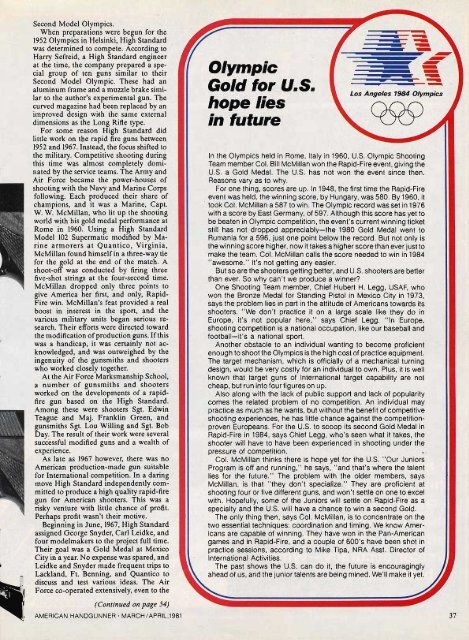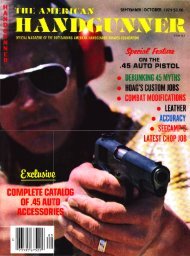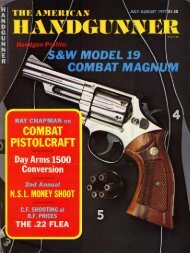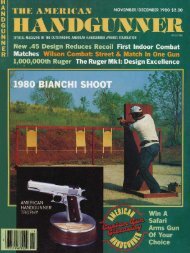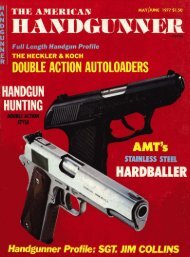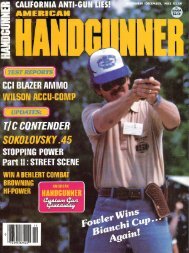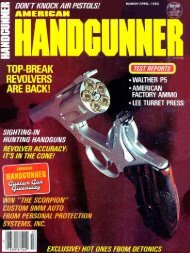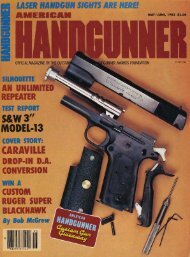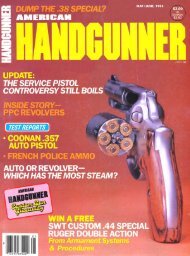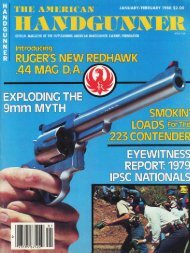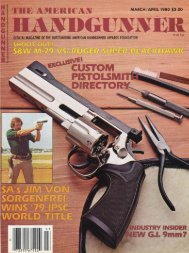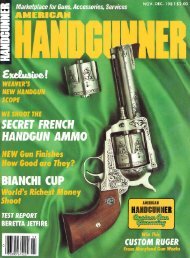American Handgunner March/April 1981
American Handgunner March/April 1981
American Handgunner March/April 1981
- No tags were found...
You also want an ePaper? Increase the reach of your titles
YUMPU automatically turns print PDFs into web optimized ePapers that Google loves.
Second Model Olympics.When preparations were begun for the1952 Olympics in Helsinki, High Standardwas determined to compete. According telHarry Sefreid, a High Standard engineerat the time, the company prepared a specialgroup of ten guns similar to theirSecond Model Olympic. These had analuminum frame and a muzzle brake similarto the author's experimental gun. Thecurved magazine had been replaced by animproved design wi-th the same externaldimensions as the Long Rifle type.For some reason High Standard didlittle work on the rapid fire guns between1952 and 1967. Instead, the focus shifted tothe military. Competitive shooting duringthis time was almost completely dominatedby the service teams. The Army andAir Force became the power-houses ofshooting with the Navy and Marine Corpsfollowing. Each produced their share ofchampions, and it was a Marine, Capt.W. W. McMillan, who lit up the shootingworld with his gold medal performance atRome in 1960. Using a High StandardModel 102 Supermatic modified by Marinearmorers at Quantico, Virginia,McMillan found himself in a three-way tiefor the gold at the end of the match. Ashoot-off was conducted by firing threefive-shot strings at the four-second time.McMillan dropped only three points togive America her'first, and only, RapidFire win. McMillan's feat provided a realboost in interest in the sport, and thevarious military units began serious research.Their efforts were direc\ed towardthe modification ofproduction guns. Ifthiswas a handicap, it was certainly not acknowledged,and was outweighed by theingenuity of the gunsmiths and shooterswho worked closely together.At the Air Force Marksmanship School,a number of gunsmiths and shootersworked on the developments of a rapidfiregun based on the High Standard.Among these were shooters Sgt. EdwinTeague and Maj. Franklin Green, andgunsmiths Sgt. Lou Willing and Sgt. BobDay. The result of their work were severalsuccessful modified guns and a wealth ofexperience.As late as 1967 however, there was no<strong>American</strong> production-made gun suitablefor International competition. In a daringmove High Standard independently committedto produce a high quality rapid-firegun for <strong>American</strong> shooters. This was arisky venture with little chance of profit.Perhaps profit wasn't their motive.Beginning in June, 1967, High Standardassigned George Snyder, Carl Leidke, andfour modelmakers to the project full time.Their goal was a Gold Medal at MexicoCity in a year. No expense was spared, andLeidke and Snyder made frequent trips toLackland, Ft. Benning, and Quantico todiscuss and test various ideas. The AirForce co-operated extensively, even to the(Continued on page 54)AMERICAN HANDGUNNER . MARCHIAPRIL,<strong>1981</strong>OlympicGold for U.S.hope liesin futureIn the Olympics held in Rome, Italy in 1960, U.S. Olympic ShootingTeam member Col. Bill McMillan won the Rapid-Fire event, giving theU.S. a Gold Medal. The U.S. has not won the event since then.Reasons vary as to why.For one thing, scores are up. In 1948, the first tim~ the Rapid-Fireevent was held, the winning score, by Hungary, was 580. By 1960, it. took Col. McMillan a 587 to win. The Olympic record was set in 1976with a score by East Germany, of 597. Although this score has yet tobe beaten in Olympic competition, the event's current winning ticketstill has not dropped appreciably-the 1980 Gold Medal went toRumania for a 596, just one point below the record. But not only isthe winning score higher, now it takes a higher score than ever just tomake the team. Col. McMillan calls the score needed to win in 1984"awesome." It's not getting any easier.But so are the shooters getting better, and U.S. shooters are betterthan ever. So why can't we produce a winner?One Shooting Team member, Chief Hubert H. Legg, USAF, whowon the Bronze Medal for Standing Pistol in Mexico City in 1973,says the problem lies in part in the attitude of <strong>American</strong>s towards itsshooters. "We don't practice it on a large scale like they do inEurope, it's not popular here," says Chief Legg. "In Europe,shooting competition is a national occupation, like our baseball andfootball-it's a national sport.Another obstacle to an individual wanting to become proficientenough to shoot the Olympics is the high cost of practice equipment:The target mechanism, which is officially of a mechanical turningdesign, would be very costly for an individual to own. Plus, it is wellknown that target guns of International target capability are notcheap, but run into four figures on up.Also along with the lack of public support and lack of popularitycomes the related problem of no competition. An individual maypractice as much as he wants, but without the benefit of competitiveshooting experiences, he has little chance against the competitionprovenEuropeans. For the U.S. to scoop its second Gold Medal inRapid-Fire in 1984, says Chief Legg, who's seen what it takes, theshooter will have to have been experienced in shooting under thepressure of competition. ~.Col. McMillan thinks there is hope yet for the U.S. "Our JuniorsProgram is off and running," he says, "and that's where the talentlies for the future." The problem with the older members, saysMcMillan, is that "they don't specialize." They are proficient atshooting four or five different guns, and won't settle on one to excelwith. Hopefully, some of the Juniors will settle on Rapid-Fire as aspecialty and the U.S. will have a chance to win a second Gold.The only thing then, says Col. McMillan, is to concentrate on thetwo essential techniques: coordination and timing. We know <strong>American</strong>sare capable of winning. They have won in the Pan-<strong>American</strong>games and in Rapid-Fire, and a couple of 600's have been shot inpractice sessions, according to Mike Tipa, NRA Asst. Director ofInternational Activities.The past shows the U.S. can do it, the future is encouraginglyahead of us, and the junior talents are being mined. We'll ma,ke it yet.37


